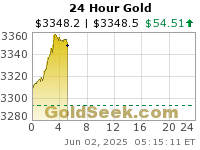*
That's it, I'm done shopping for today. Here is my first purchase for the day - Anooraq Resources Corp (ANO) at $1.02.
*
Click on the chart to ENLARGE
And my second purchase was for some New Gold Inc (NGD) at $5.10.
*
Now I can just sit back and wait to see if I catch a fish (or two).
*
Click on the chart to ENLARGE
I had an order to sell BAA @ $1.98 and they took me out.
*
My TSI trading record has been updated to reflect today's two purchases and one sale.
*
Click on the chart to ENLARGE
*
I could not resist another excellent setup. This is Claude Resources Inc (CGR). I bought shares at $1.02.
*
My TSI trading record has been updated to reflect today's three purchases and one sale.
*
Click on the chart to ENLARGE
Political board
22 hours ago




![[Most Recent Quotes from www.kitco.com]](http://www.kitconet.com/images/quotes_special.gif)




John, I have a question about your trading record. I don't see how your cumulative percent can be calculated by adding the individual percentage moves since the amount of capital you use varies from trade to trade. If you were to buy 100 shares of XXX at $10.00 per share ($1000) and make 10% ($100), but the next trade you trade $20,000 of YYY at $10.00 per share and you lose 10% ($200), you are not even. How are you calculating the cumulative percent change? I calculate mine against my total trading capital. So, if I start with $10,000 and make a trade using only $1,000 and gain 10%, the gain I would acknowledge would be $100 on $10,000, or 1%, not $100 on $1,000 (10%).
ReplyDeleteGarry - you are absolutely correct in everything you have written. Perhaps you can see that I simply added the % of gain/loss from the first trade, to the next, to the next, and so on.
ReplyDeleteObviously if I hold 4 positions they cannot all, each, be 100% of my capital. Because I often carry more than a single position at a time, the total of my funds are in several places simultaneously. Call it a psychological motivator if you wish, but this accounting helps me see how each of my trades would have added up had I used my entire account on each trade, which obviously I do not.
My personal goal is to see the current 60% number reach 500-1,000% in a year. It's just a goal and a way for me to play a competitive game with myself. That's it. LOL
Indeed, my actual trading account has not increased 60% in the past 6-7 weeks. Rather, it has increased about 20+%.
Nice catch, good questions, and thanks for letting me clear that up for anyone who may have been confused or did not recognize that I was adding up the % gains of each individual trade, one to the next.
John, Thanks for clarifying that, I liked the numbers and was ready to hand over my account to you ;-) 20% is still great though, we all would like to do that every couple of months.
ReplyDeleteNo signal for GDX today from $BPGDM, but another down day tomorrow might trigger a sell signal. I would not take that signal since the TSI is still below the zero line and hence not strong downside momentum from this TSI level. It looks like a short signal is when the TSI falls from above zero to below, just the opposite of the buy signal. The opportune moment seems to be 1-2 bars after the TSI has moved above (long) or below (short) the zero line in the trending direction. The point to get out if it fails is when the TSI breaks back below (long) or above (short) the zero line. In most cases that is a very small loss, and it doesn't happen often, so there are good odds of success.
I'm going to have to go through all your blog posts to understand how you are trading using the TSI/MFI, I'm just creating my own rules using the two indicators and backtesting them. It looks great when you are trading with the trend, and if you have a losing trade it means the trend is changing or going sideways, so just wait for a new TSI and MFI low and take another shot. Good trading.
Garry